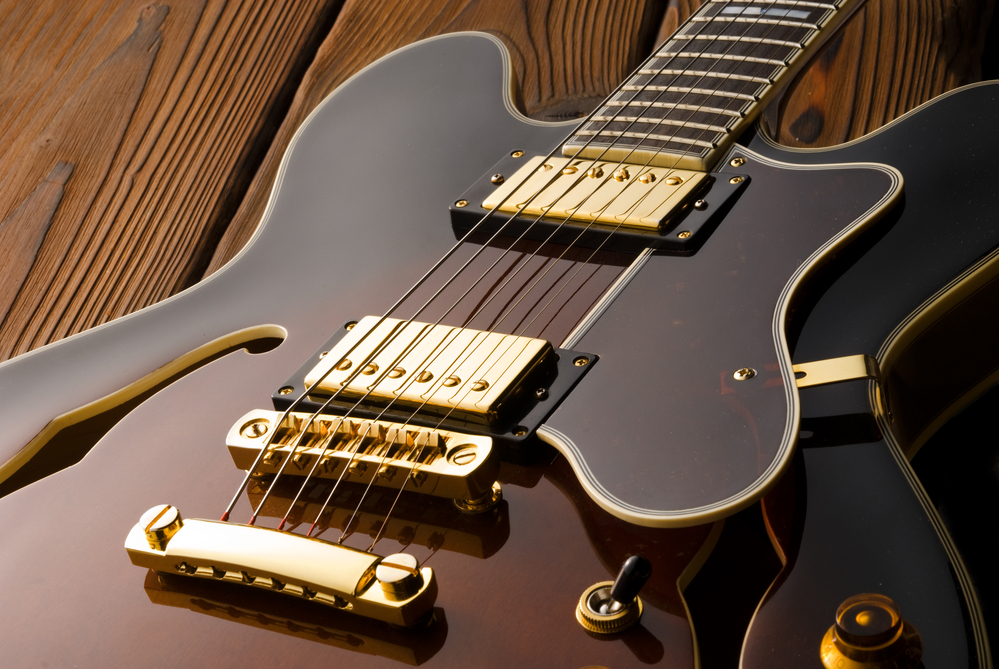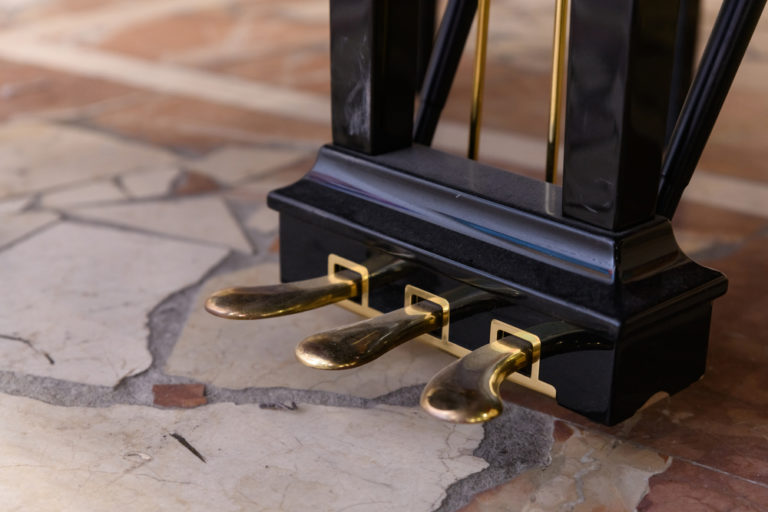22 Types of Guitars: The Definitive Guide (2024)
The various types of guitars that exist in our world are so numerous that choosing the best one suited for your needs might seem impossible at first. Let us explore the most common guitars, all the way up to some models that might seem alien at first, and show you what they’re all about!
Acoustic guitars
The acoustic guitar is the most common variant of guitars, and there are two main types of acoustic guitars. One is the steel-string guitar, and the other is the classical, nylon-string guitar. There are some differences between the two.
One main difference between the two guitar types is the material from which the strings are made: Stainless steel and a nylon/steel composite. Many other subtypes exist, such as the electro-acoustic guitar. The acoustic guitar is excellent for folk, neo-folk, country, classical music, and plenty more!
Steel-string guitar
A guitar-type scion of the nylon-string guitar, the steel-string provides a brighter and louder sound, this becoming the particular term of “acoustic guitar.”
You can play any type of music on this instrument, but it is usually used in classic rock, country, and traditional Irish music.
A unique fact about these different types of acoustic guitars is that it provides the strength, together with the thickness of the string (usually recommended to be in the .012 or .013 as the thinnest string), to use open tunings such as Open G (D-G-D-G-B-D), Open D (D-A-D-F#-A-D), or the DADGAD, also known as the Celtic tuning,
The sound it makes is a more pronounced ringing of the strings due to the material’s nature, with a lot of sustain on the low notes and pronounced high notes (from the 12th fret onward).
Music types: Classic rock, Country, Celtic music (Irish, Scottish, English)
Learning difficulty: For beginners
What it offers: Smooth transitions from low to high notes, prolonged sustain
Nylon-string classical guitar
The nylon-string classical guitar, or just classical guitar, is the precursor of the modern acoustic and electric guitars.
You can play any music on it, from classical pieces such as Rodrigo’s Concierto de Aranjuez, Vivaldi’s Guitar cogivesto in D to Django Reinhardt’s Minor Swing, and other songs.
The strings used on this are made either out of a nylon/steel composite or made of gut (usually sheep gut), which gives it a warmer, punchier, but dampened sound.
There are many classical guitars, but the most common shape is either the modern classical guitar or the “historic” classical guitar, which is similar to the early romantic guitars from France and Italy.
Music types: classical, jazz, swing.
Learning difficulty: For intermediates
What it offers: Warm, dampened sound, 12th fret bound to the body.
Archtop guitar
This is a hollow-body or semi-hollow body with a distinctive arch top and back, f-holes like the classical instruments such as the violin and cello, a vibrato bridge, and it is joined at the neck at the 14th fret.
This is usually the favored instrument of jazzmen, bluesmen, and rockabilly players, but it can also be used in hard rock, such as the guitars that Ted Nugent uses when playing.
These guitars usually come with a Bigsby vibrato bridge, which, as the name describes, lets the player do vibrato without bending the string.
It makes a percussive, heavy mid-range sound, perfect for playing acoustically in a big band, and amplified it sounds very mellow, giving that signature jazzy sound.
Music types: Jazz, Blues, Rockabilly
Learning difficulty: For intermediate
What it offers: heavy mid-range percussive sound, excellent big band instrument, but it tends to feedback.
Electro-acoustic guitar
This is a typical acoustic guitar. A pickup, usually a piezo or magnetic pickup, and an input jack and a preamplifier incorporated into the body have been added.
This guitar’s preamp usually comes together with an incorporated tuner and an EQ, with up to 6 slots for the different frequencies that the guitar produces.
This guitar came into existence in the early 1920s when the guitar was being outplayed by the horn and percussion sections of big bands. It would, in time, combine the guitar styles of both electric and acoustic.
Interestingly, the first “amplifier” was actually a telephone transmitter used inside violins and banjos to amplify. After that, the carbon button microphones were created, and these used the vibrations of the bridge, but unfortunately, the signal was relatively weak.
The sound is similar to the standard acoustic guitar, with a few enhancements provided by the preamp’s EQ.
Music types: rock, pop, country, blues;
Learning difficulty: For beginners
What it offers: Smooth transitions from low to high notes, prolonged sustain, enhanced specific frequencies.
Resonator guitar
When it comes to resonator guitars, two acoustic guitar types are prominent. A tabletop guitar version with a square fretboard meant to be played on a table or in your lap with a slide (you can use anything as a slide), as a sort of lap steel guitar, and one with a round fretboard which can be played with the typical guitar posture.
This guitar can be tuned with any tuning (E standard, D standard, Open D, Open G, etc.).
This guitar’s body is usually made from wood, but it can also be made out of metal and other materials.
The most common resonator is the one with a single cone and two soundholes, but some resonators have three or more cones and only one soundhole.
Music types: Hawaiian music, jazz, blues, swing
Learning difficulty: For advanced
What it offers: dampened sound, different tunings, and playstyles (in the lap)
Flamenco guitar
The flamenco guitar is a cousin of the regular classical guitar. It has a thinner top wood and less bracing, strung with nylon strings, grittier sound, and more percussive than the classical guitar.
These guitars usually have a very characteristic body color due to the sycamore or cypress wood composition.
The posture for playing flamenco guitar is a bit different from the classical guitar, players alternating between the soundhole and the bridge, which produces a harsher, raspier sound quality.
For example, flamenco guitarists cross their legs and support the guitar on whichever leg is on top, accommodating the player to play with different techniques such as tremolo, golpe, and rasgueo, which can be played correctly if the elbow supports the upper right arm. Strings are “struck” instead of plucked, this being the percussive sound we hear when playing.
Music types: Flamenco, Baroque, Renaissance music.
Learning difficulty: For advanced
What it offers: percussive tone, gritty sound due to thinner top, and less bracing
Electric guitars
Electric guitars are among the widest used instruments in our modern age. All types of electric guitars need external amplification to be heard and to do that.
They use the implemented pickups (humbuckers, single coil, etc.) and a cable to connect the guitar’s output jack to the amplifier’s input.
All kinds of guitars exist in the electric realm, and they differ in body and headstock shapes from all companies (Jackson, Gibson, Fender, etc.).
Different guitar names exist for each shape from every company as well: The Les Paul and Flying V from Gibson, the Stratocaster and Telecaster from Fender, the Kelly and King V from Jackson, and other prominent guitar names. These types of guitars are mostly used in jazz, blues, rock, and metal.
Solid-body electric guitar
Solid-body electric guitar types have no vibrating soundboard to amplify the strings. Instead, they depend on electric pickups and an amp. The solid-body provides a “gating” aspect, which ensures that no “wolf” tones are present and that only the string vibration is reproduced.
The first-ever solid-body electric guitar was invented by Les Paul (the one whose name now serves as the flagship of the Gibson Guitar Company). Before it got its iconic shape, the first electric guitar, named “The Log,” had a Spanish guitar’s body style.
The first mass-produced solid-body was the Fender Esquire and the Fender Broadcaster (soon to be renamed as the Telecaster), and soon after, the iconic Gibson Les Paul issued a challenge.
Music types: Rock, Blues
Learning difficulty: for beginners
What it offers: Smooth tones
Hollow body electric guitar (semi-acoustic, thinline)
The hollow body electric guitar originated in the 30s, having both a sound box and electric pickups. There are significant differences between these and the acoustic-electric guitar, as in the AE guitars, either the manufacturer or the player adds a pickup to the guitar.
Being insignificant, guitar players wanted to increase their guitars’ sound. Enter the Charlie Christian pickup, a magnetic single-coil pickup that converted the vibrating strings’ energy into an electrical signal.
That sound quickly became popular among jazz artists because of how cleanly the sound was translated from the vibrating string through the cable and out of the amplifier.
Through the years, many companies, such as Rickenbacker, Gibson, Danelectro, and others, have tried to upgrade the hollow and semi-hollow body guitars, and their quests were wrought with success.
Music types: Jazz, blues
Learning difficulty: for intermediate
What it offers: warm, percussive tone, similar to that of the archtop guitar, good guitar for rhythm, not so great as a solo instrument.
Archtop electric guitar
This is a hollow-body or semi-hollow body guitar with a distinctive arch top and back, f-holes like the classical instruments such as the violin and cello, a vibrato bridge, and it is joined at the neck at the 14th fret.
This is usually the favored instrument of jazzmen, bluesmen, and rockabilly players, but it can also be used in hard rock, such as the guitars that Ted Nugent uses when playing.
These guitars usually come with a Bigsby vibrato bridge, which, as the name describes, lets the player do vibrato without bending the string. It makes a percussive, heavy mid-range sound, perfect for playing acoustically in a big band, and amplified it sounds very mellow, giving that signature jazzy sound.
Music types: Jazz, Blues, Rockabilly
Learning difficulty: For intermediate
What it offers: heavy mid-range percussive sound, perfect big band instrument, but it tends to feedback.
Bass guitars
Let’s talk about some different guitars, namely bass guitars. They are the lowest-pitched in our guitar list. With an electric or acoustic guitar’s appearance, the bass has a longer neck and scale length.
The string number varies from the original 4 to 5, 6, 7, and more strings. Starting from 1955, the bass guitar has practically replaced the double bass in popular music, such as jazz, swing and has become pivotal in creating new genres.
Acoustic bass guitar
There are different types of bass guitars, but let’s start with the ABG (acoustic bass guitar). It is a steel-stringed instrument similar to the acoustic guitar but with a longer neck and scale length.
This bass’s tuning is similar to the last four strings on the guitar (E, A, D, G) and is thus tuned an octave lower than them.
Acoustic basses usually have pickups and a preamp to be heard, helped by a magnetic or a piezo pickup, as it may be hard to listen to the low frequencies with just an acoustic body.
A fun fact, the Mexicans have a “guitarron,” which are large deep-bodied six-string guitars played by mariachi bands.
Music types: rock, pop, Mexican Mariachi music
Learning difficulty: for intermediate
What it offers: deep, gritty bass frequencies, when amplified, a sound closer to that of the double bass.
Electric bass guitar
With an electric or acoustic guitar’s appearance, the bass has a longer neck and scale length. This instrument is used to provide the low frequencies and the groove to the songs that it accompanies.
The descendant of the double bass, the electric bass, is written in the bass key, players having to transpose the notes from treble to bass and are five times smaller than its ancestor.
Musicians like Victor Wooten and Marcus Miller are just two examples of bassists that take the bass out of the rhythmic and into the melodic.
Music types: Rock, jazz, Metal
Learning difficulty: for beginners
What it offers: rich, deep tones, thicker strings
Semi-acoustic bass guitar (semi-hollow)
This semi-acoustic bass is very similar to the hollow-body or semi-hollow body guitars.
This concept dated back to the 30s and was manufactured before the solid body’s invention, having F-holes, much like their acoustic cousins, the cello and the double bass, and frequently it has either a flat top or an arched top.
They are more resonant and have a lot more tones to be able to use in comparison to their solid body counters. A great example of a semi-acoustic bass is the Ibanez AGB 200.
Music types: jazz, blues, swing
Learning difficulty: for intermediate
What it offers: warm, clean sound, great sustain.
Headless bass guitar
Starting in the 1980s, Ned Steinberger presented the “headless” bass to the world, which connected the strings from nut to bridge and not bridge to the nut as the regular basses would do.
The tuning keys are located on the instrument’s bridge, allowing the player to tune with his right hand rather than his left and reduce tuning time due to this fact.
More and more guitar companies have decided to try out the “headless” fad in recent years, and some companies appeared exclusively to present headless instruments, such as Strandberg and Kiesel.
Music types: Rock, Pop
Learning difficulty: For intermediate
What it offers: warm, clean sound, great sustain
Other types of guitars
We also have different types of guitars, such as the 12 string, the steel guitar (lap and pedal steel), touch guitars, double neck guitars (such as Jimmy Page’s Epiphone used on Stairway to Heaven), left-handed guitars, and much more!
All these kinds of guitars have their own personality, tunings, and sound when played. Some have to be strummed, some have to be tapped, and some have multiple strings (the harp guitar) which:
- Remind of the theorbo
- Are quite rare
- Have supporting open bass strings
Left-handed guitar
Left-handed guitars are just electric, acoustic, and bass guitars made for left-handed guitarists.
They were few, only being custom made for those that needed them, but they have started to gain traction in the music world and have become widely available.
Lefties come in all shapes, sizes, and string numbers, ranging from acoustic guitars to 8 and 9 string guitars and basses.
The pickups and the amplifier produce all sounds, so depending on them, you can have a warm, clean sound, or something very gritty and distorted, if you are into heavier stuff.
Music types: Rock, Metal, Jazz10
Learning difficulty: for beginners
What it offers: great sustain, gritty, distorted sound (through an amp), warm, clean sound.
Twelve-string guitar
A steel-string guitar that provides the players with the ability to play 2 octaves at once, with a thicker, more ringing sound than the standard six-string guitars.
The headstock is longer to accommodate the 12 tuning machines, the neck and body are
heavily reinforced as not to succumb under the pressure of the strings, with a shorter fretting scale to reduce overall string tension.
The most common type of 12 string is the acoustic version, even though there are also electric 12 string guitars.
Music types: Country, Rock, Jazz
Learning difficulty: For intermediate
What it offers: “chorus” effect due to the octaves being played together
Double-neck guitar
The double-neck guitar has its origins in the Renaissance. The most common two-necked guitar is an electric guitar with a 12 string guitar and a six-string.
Some guitarists even go to lengths to have a multi-neck guitar; see Michael Angelo Batio, who has a quadruple neck guitar.
A fun tip for this guitar is that you can tune one of the guitars, preferably the six-string, to a specific chord and play on the 12 string, occasionally strumming the chord. A downside to this type of guitar is that you need to know your stuff to play it.
Music types: Rock, classical music
Learning difficulty: For advanced
What it offers: the chorus effect given by the 12 string, the ability to tune the other guitar to a specific chord.
Touch guitar (DuoLectar or Electronic Mute)
The touch guitar is a guitar designed to use some different guitar playing styles such as tapping (hammer-ons/pull-offs, double-tapping, harmonic tapping, etc.) This type of guitar can come both in a single neck and a multi-neck version.
Similar in appearance to a regular guitar, the strings react to touch and tapping, not to plucking and strumming, although, in recent years, touch guitars have become accustomed to being strummed and plucked.
This instrument can produce melodies and rhythms simultaneously, with the left hand tapping the rhythm in the bass and the right hand tapping the melodies.
Music types: rock, jazz, Latin
Learning difficulty: for advanced
What it offers: percussive sound
Steel guitar (lap steel, pedal steel)
The lap steel guitar, or the table guitar, is a Hawaiian instrument. It changes pitch with the help of a polished steel bar against the plucked strings, differing a lot from acoustic guitar styles of playing.
The tunings for this guitar differ from player to player, but common ground is the E standard tuning, but they are usually tuned to a chord best suited to the singer’s voice, usually in an open tuning.
Hawaiian music in the 1910s, more specifically 1916, outsold all US musical genres due to the fad and obsession in the United States.
Music types: Hawaiian music, blues, and rock
Learning difficulty: for advanced
What it offers: full resonant tones of open strings, ability to play it in your lap
Harp guitar
The harp guitar is quite a rare sight, and usually, it must have at least one unfretted string lying off the fretboard.
The family consists of various configs, most commonly identified being the American Harp guitars with either multiple strings or another neck.
The sound of this instrument tends to float around the mid-range strings. A famous Russian guitarist uses a harp guitar with floating sub-bass strings, similar to the Indian sitar.
The downsides of thy type of guitar are its low notes and possibly its high notes. It certainly won’t do well in heavier genres, but it will bring a lovely ambiance sound in classical ones.
Music types: country, bluegrass, classical
Learning difficulty: for advanced
What it offers: a true harp-like tone, the warmth of a classical guitar.
Guitar cousins
These are not types of small guitars per se, but they are related somehow, be it contributing to its invention or being invented because of the guitar. Though there are many guitar types and names, some distant cousins of the guitar, like the ukulele, are not technically guitars.
They are related in some way, be it contributing to its invention or being invented because of the guitar. These types of small guitars are used in various cultures and were later known to the world through their traditional songs.
Ukulele
The ukulele is the smallest Hawaiian guitar, and it has four nylon strings, one up-octave G string, and the three remaining are in normal pitch.
This is a great instrument if you want to start learning how to strum. It was introduced to Hawaii by Madeiran immigrants.
Ukuleles can be built using wood and other materials such as plastic—the figure 8 body, which is that of a small acoustic guitar. Modern ukuleles are often seen in non-standard shapes: with a cutaway, or more oval in shape, or in the form of a cigar box.
Music types: Hawaiian music, pop
Learning difficulty: For beginners
What it offers: small body and neck size, spruce tonewood
Mandolin
The mandolin. A member of the lute family, usually plucked with a plectrum, poses four pairs of strings, but there have been accounts of 5 and 6 string pairs on a mandolin.
There are many styles in which a mandoline can be made, but the most common types are the “Neapolitan,” the archtop, and the flat-back mandolin.
The flat-back tone is mellow and warm, perfect for those intimate folk music gigs where only a handful of people can join.
Music types: country, jazz, classical
Learning difficulty: for beginners
What it offers: warm, mellow tone, doesn’t punch “through the mix” like the carved top.
Banjo
A stringed instrument with a membrane stretched over a cavity to form a resonator. Circular in nature, it can be made of different materials such as plastic or animal leather.
The sound which results from said resonator is a very punchy, metallic sound, much like the springs of a snare drum’s resonant head.
Early forms of the banjo were adapted from African instruments of similar design. Along with the fiddle, the banjo is a mainstay of American music styles such as bluegrass and “trad” jazz.
Music types: country, bluegrass, jazz, Celtic music
Learning difficulty: for advanced
What it offers: mellow tone (gut strings), distinctive metallic sound
FAQ
What are the three types of guitars?
The three main types of regular guitars are the acoustic guitar, the electric guitar, and the bass guitar, all of which have similarities and differences.
How many types of guitars are there?
There are different kinds of guitars that can be grouped together, but some variations put them into different types altogether. There are acoustic guitars, electric guitars, bass guitars, and their cousins and variations.
Which type of guitar is best?
The best type of guitar is the one that suits your needs the most, each and every one having its quirks and qualities, but also its weaknesses.
What is the easiest guitar to play?
There are types of guitar for beginners that are the easiest to play. All guitars take up practice time to learn all the bits and pieces needed to play efficiently, but the acoustic guitar is probably the best start.
What is a five-string guitar called?
The 5-string guitar is called a Baroque guitar or a chitarrone, which was the most common instrument to be found in the house between the year 1600 to 1750 when the musical world started to change.
What is the hardest type of guitar to play?
All types of guitars need the practice to learn all the bits and pieces required to perform effectively. The more strings a guitar has or other alien-like features, the harder it is to play it.







